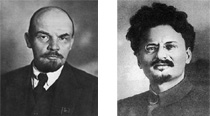The article below may be copied and circulated but proper attribution of authorship is required.
American "New Economy" — a giant Ponzi pyramid.
By F. Kreisel, June 15th, 1998.
Those of you who follow the developments of American economy and business must have noticed the enormous role which the chairman of the board of the Federal Reserve Bank, Alan Greenspan, seems to play in the direction and prolongation of the so called "American economic miracle". His words, always in a long winded and pontificating style, always conditional, hedging and equivocating, are listened to with awe across stock markets the world over. Despite the fact that over the past few years he was rarely right in his forecasts (remember his warning of "unwarranted exuberance" of the markets a year and a half ago), he is given full credit for masterfully juggling the interest rates, which are today the main driving force of this "business expansion". Here, for example is a typical statement from the New York Times: "No one else has had the power to move markets in recent years the way Alan Greenspan, the Federal Reserve chairman, has" (NYT, June 14, 1998).
We are far from fetishizing this particular central banker, see for example another comment we made on Paul Krugman's religious belief. The very fact that American capitalism makes so much of this one man reveals the inner uncertainty of the system, its innate instability. However, it is instructive to hear what Greenspan had to say about the big picture of this seven year old "economic miracle".
In one recent speech he described a "virtuous growth cycle" of the American economy in which the normal rules of the business cycle, with its booms and busts, seem to have been suspended. He spoke of the widespread expectations that
"low inflation and stronger productivity growth would allow the extraordinary growth of profits to be extended into the distant future. Indeed, expectations of per-share earnings growth over the long term have been undergoing continuous upward revision by security analysts since 1994. These rising expectations have, in turn, driven stock prices sharply higher and credit spreads lower, perhaps to levels that will be difficult to sustain unless economic conditions remain exceptionally favorable — more so than might be anticipated from historical relationships.
"In any event, primarily because of the rise in stock prices, about $12,000 billion has been added to the value of household assets since the end of 1994. Probably only a few per cent of these largely unrealised capital gains have been transformed into the purchase of goods and services in consumer markets. But that increment to spending, combined with the sharp increase in equipment investment, which has stemmed from the low cost of both equity and debt relative to expected profits on capital, has propelled the economy forward".
The right wing of what passes for the American political spectrum, the crowd at the "Wall Street Journal" and the "Business Week" have labeled this phenomenon "the new economy". According to them, the old laws of supply and demand have stopped applying in the information economy. With the advent of computers and the Internet there is an ever increasing demand and market for kilobits and megabytes of information. Both the supply of and the demand for this information, and all of the fanciful financial instruments which the wizards of Wall Street have dreamed up, can therefore increase ad infinitum. In a sense, you can just keep adding zeros both to the GNP and to the bottom line.
Let us consider again what the chief central banker of the United States has described. The unusually long business expansion in the US is not due to a significant expansion in the production of goods and services intended for human consumption. Just the reverse, the living standards of the bulk of the American middle class are stagnant, while most workers are earning less than forty years ago. True, the prevailing low interest rates encourage plant renovation and equipment renewal. In fact, the accelerating cycles of product development and the continuing technological revolution are forcing each industrial firm to renew itself ever quicker and faster, to spend considerable moneys on research and development, to reengineer itself, to renew equipment every couple of years, in short, to run ever faster in order to stay in the race for global competitiveness.
Greenspan is describing a process where a huge percentage of the American public (70% of all households according to one account) have in the past few years put their savings into stocks, bonds, CDs and other financial instruments. The average savings rate in the US dropped to a historic low of 3% of income, but it is now possible to borrow money in many more ways than ever before. Mortgage companies will lend you 125% of the value of your house. — Yes, that is correct, the banks will lend you more than your house is worth! — Mortgage loans, personal loans, credit card debt, revolving loans, car loans have provided the funds for the American worker to buy more and more of this ever increasing mountain of capital.
Since 1994 the valuation of company stocks, as evidenced by the Dow-Jones Averages, has been increasing by 20, even 30% annually. To compete for investors these companies must both force their share prices higher and also pay interest on their capital, and they manage to do so by reengineering, by cutting out both production and the production workers employed in it, by investing their own earnings in various ever more fanciful financial instruments. The most successful, by Wall Street standards, of the American auto manufacturers, Ford, is embarked on a round of slashing production of the less profitable makes of cars and plant closures. Its directors know that the more workers they lay off, the higher will their share prices rise, and all the savings from rationalization and production cuts will be used by Ford to invest in new financial manipulations by their teams of mathematicians, economists and lawyers. We are witnessing today throughout American and world economy an unprecedented flow of industrial capital into financial speculation. The domination of banks over the industrial producers, first noticed and commented on by socialists and Marxists early in our century, is today complete.
Greenspan does not address the issues of production directly; he is talking of consumption, or rather, the absence of consumption by the new stock owners. Most of them, the working and middle class investors, have been persuaded by the prevailing individualistic and short sighted culture of America to put all the money they own and all the money they can borrow into this "miraculous money making machine". Yesterday's news informed us that a meeting of the stockholders of Digital Equipment Corporation (many of the small stockholders are the present and past employees of this important computer maker) voted in favor of being bought out by another computer maker, Compaq. The irony is that this particular step in the consolidation and rationalization of American business will result in the layoff of fifteen thousand DEC and two thousand Compaq workers, many of them stockowners. The price of both Compaq and DEC stock, by the way, went up on news of layoffs and plant shutdowns.
The American "miracle economy" described by Greenspan is, plainly speaking, a giant pyramid investment scheme. Such a "Ponzi scheme" is defined by the Encyclopedia Britannica as "an investment swindle in which some early investors are paid off with money put up by later ones in order to encourage more and bigger risks". The present Wall Street investment scheme differs from the past schemes of this type — the original Ponzi scheme invented by an American crook, Charles A. Ponzi, the MMM pyramid in Russia, the Albanian pyramids which collapsed in early 1997, and so on — by its huge scale and importance to the world economy. If a sizable number of the present investors decide to take their money out, the giant mountain of "values", inflated by debt and credit, will collapse. When we bear in mind that most of today's investors put their life's savings into this scheme in the expectation of being provided with income out of it upon retiring, we begin to realize what human tragedy lies in store for them. If we now consider that the Gross Domestic Product of the United States was only $7.61 trillion in 1996 (the last year for which we have data) and compare it with the $12 trillion of the "miracle money" accumulated just since 1994, we can see the scale of the disaster looming over the American and world economy.
It is fashionable in today's business press to criticise the East Asian and Japanese business leaders and governments, blaming them for the collapse of the "tigers" and the "Japanese bubble economy". But Mr. Forbes, in order to see the supervillain in this gigantic shell game, just look in the mirror!
One hundred years ago a German revisionist of socialist doctrine by name of Eduard Bernstein observed the spread of relative prosperity among many German workers and hypothesized the eventual move in the direction of "people's" or democratic capitalism. In 1914 these hopes were dashed by the eruption of World War I and the destruction of both human lives and capitalist wealth. At the end of this century the ideologues of American and world capitalism are promoting elitist and fantastic ideas of individualistic success, beneficial inequality, further cuts in the already tattered social safety net, in short, the law of the jungle. They are demanding that even the minute remnants of a needs based distribution system, like the Social Security fund and workers' pensions, be thrown into the gigantic Ponzi scheme run by the dealers of Wall Street.
After seeing the collapse of the "Asian tigers" and of "fortress Japan" we may witness the implosion of the American mountain of trillions of dollars of make believe values. This would be an unmitigated disaster for the American workers. But capitalism makes this disaster inevitable.




